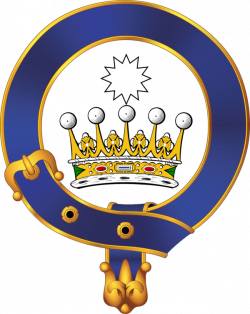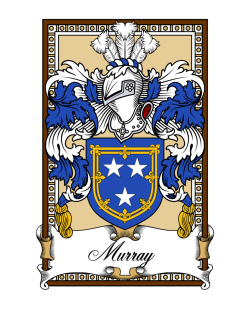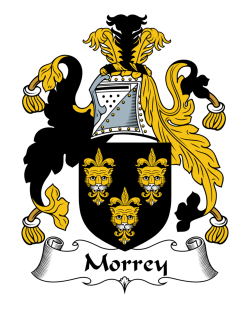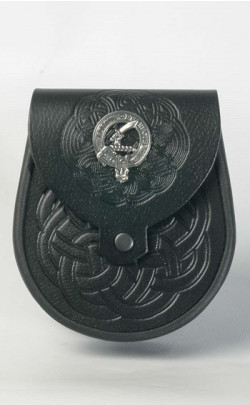
Clan Murray
QUITE READY
Clan Murray can trace their heritage to Freskin, a Flemish nobleman from the 12th century. He was gifted the kingdom of Moray, and the surname Murray is subsequently derived from the area.
The Murrays were strongly in support of both William Wallace and King Robert the Bruce in the Scottish Wars of Independence, and in the 17th century were embroiled in a deadly feud with clan Hannay, which led to the latter clan being outlawed.
The Murray clan motto is "Tout prest" (Quite ready) and the clan crest is a mermaid holding a mirror and comb.
The Tartans
of Clan Murray
Scottish History
of Clan Murray
Family fortunes
The Murrays are the most titled family in Scotland and this is as it should be since their gift for leadership has distinguished them from the beginning of their history. The family name is derived from the province and later county of Moray, one of the oldest political units in Scotland. The word probably comes from the Roman Murravia which meant a land or settlement by the sea.
In the early Middle Ages, as Shakespeare and Macbeth testify, Moray was as important as any part of the country. In fact it was only brought under full Scottish control in the 12th century when David the First destroyed the old house of Murray by forbidding its heirs to marry and gave feudal possession of the district to a Flemish knight. This military adventurer was probably the originator of the Murray family since he was soon referred to as Friskin the Murravia and founded a cadet line which acquired the lairdship of Bothwell and Clydesdale and was known in the 13th century as De Moray.
Andrew De Moray played a prominent part in the Wars of Independence against England and was officially superior to William Wallace in the Scots army that defeated the English at Stirling Bridge in 1297 and some historians think that he, rather than Wallace, was responsible for the victory.
Whatever the case, Sir Andrew was killed towards the end of the fight and Wallace acquired undisputed leadership of the Scots cause through the dark days which followed the defeat at Falkirk one year later.
The last De Moray, Laird of Bothwell, died of the plague in 1360, leaving only their magnificent castle, now ruinous, a testament to the family’s power and, since the direct line had by this time died out, the chieftainship of the family fell into dispute.
Eventually in 1542 the line of the Murray Lairds of Tullibardine in Strathearn was recognised by the Lyon Court as chiefs of the arms of Murray. The descent of this branch is uncertain though family tradition traces it to one John De Murravia who was Sheriff of Perth in 1219. Certainly the first Laird of Tullibardine acquired his title by marrying the daughter of the Earl of Strathearn in 1284 and choosing to live with her in the Highland part of the Strath to the west of Crieff.
His son Andrew dealt a severe blow to the family’s fortune by backing the Balliol claimant who tried to regain the throne on the death of Robert the Bruce. Though the rebels defeated a royal army in 1532, Andrew Murray was captured on a visit to Perth the next year and beheaded at Stirling Castle for treason.
After this abberation, the Tullibardine Murrays understandably kept quiet for several generations and the next Laird we hear of is Sir David who in 1430 married the daughter of Sir John Colquhoun of Luss who gave him no fewer than 17 sons and five daughters. We are told that all the boys slept in a monstrous circular bed with a single pole running down through the middle at which they placed their feet and hung their swords. On one occasion Sir David invited to his home King James the Second who was rather timid and lived in fear of armed plots. Sir David made the mistake of parading all his boys in full armour to honour the King’s arrival. Next day James issued a proclamation making it an offence to parade private armies in the King’s presence and had Sir David hauled before him for breaking this retrospective law. When the proud parent told him that all 17 were his own sons, the king was astounded and dismissed him without punishment.
Conspiracy and murder
In 1542, as we have seen, the Tullibardines were recognised as chiefs of Murray. Their leadership was consolidated at the time of the Reformation in 1560 when the chief was one of the Protestant lords of the congregation who overthrew the French Catholic Mary of Guise and allowed the reformers to form their own government and establish the Free Kirk of Scotland.
In 1567 the Laird of Tullibardine and his younger brothers fought with the Protestant army against Mary, Queen of Scots and Bothwell at Carberry Hill. Before the battle, Bothwell issued a challenge to his opponents by throwing down his gauntlet and offering to fight whoever picked it up. Though the Laird of Tullibardine and his younger brother sprang forward, they were spurned by Bothwell as inferior in rank.
In 1586 the supremacy of the Tullibardines was confirmed when the Laird succeeded in getting Murrays from all over Scotland to swear allegiance to him at a mass gathering at Perth. Among those who took the oath were Murrays from Perthshire, Stirlingshire, Dumfries and the Borders.
The power of the Tullibardine Murrays was further enhanced by two important events at the beginning of the 17th century. They acquired by marriage the immense estates and clan following of the Stewart Earls of Atholl whose line ceased in 1625. At one stroke the Murrays became masters of 200,000 acres covering most of Perthshire, more than 1000 of the most warlike clansmen and the strongest and most strategically placed fortress in the north, Blair Castle just outside Blair Atholl.
With all this, the Murrays rose quickly into the class of super chiefs like the Campbell Earl of Argyle and the Gordon Marquis of Huntly with immense land holdings and family connections all over Scotland and the unwavering allegiance of the broken clans who inhabited their estates.
The Murrays of Atholl won royal favour as a result of their service to King James the Sixth at the time of the mysterious Gowrie Conspiracy.
The King and some members of his Court, including the Master of Tullibardine and his kinsman Sir David Murray, were invited to visit John Ruthven, the Earl of Gowrie, at his house outside Perth in the summer of 1600. During dinner the King was called out of the room by Gowrie and threatened with assassination. The courtiers, meanwhile, were told that the King had ridden off to Stirling and they all rushed off downstairs to their horses to follow suit. Luckily, James escaped from his guards for a moment and managed to climb up to a window, shouting “Help! Treason and murder!” to the knights mounting up below. The courtiers ran back into the building and, as Gowrie was hacked to death in the room where James had been held, Tullibardine and Sir David Murray chased Gowrie’s brother down the back stairs into the garden where he too was despatched. The King was grateful for his deliverance and this, together with the clumsy character of the plot, led many to suspect that James had arranged the whole thing to rid himself of the two Gowries who were the most powerful noblemen of the day.
Whatever the truth, the Murrays were showered with favours. Sir David’s family received the Gowrie Palace at Scone and the title Viscount Stormont. Lord Tullibardine was given most of the Gowrie land west of Perth and later, of course, the disputed succession to the title and estates of Atholl. Therefore when the great quarrel broke out between the next Stuart monarch Charles the First and his Covenanting subjects led by the Earl of Argyll, the Murrays of Atholl were amongst the strongest supporters of the royal cause.
Family History Mini Book
We hope you enjoyed reading this excerpt from this mini book on the Scottish history of the Murray family.
You can buy the full book for onlyEnglish History
of Clan Murray
Ancient roots
Ranked at 98th in some lists of the 100 most common surnames found in England today, ‘Murray’ has roots that stretch back to not only the ancient Picts of Scotland but also to a warrior knight who was involved in one of the most pivotal events in the frequently turbulent history of the British Isles.
To untangle the complex genealogical skein that proud bearers of the Murray name are heirs to and to explain why bearers of the name today are not identified with any particular part of England, we have to travel back through the dim mists of time to 1066.
By this date, England had become a nation with several powerful competitors to the throne.
In what were extremely complex family, political and military machinations, the monarch was Harold II, who had succeeded to the throne following the death of Edward the Confessor.
But his right to the throne was contested by two powerful competitors – his brother-in-law King Harold Hardrada of Norway, in alliance with Tostig, Harold II’s brother, and Duke William II of Normandy.
In what has become known as The Year of Three Battles, Hardrada invaded England and gained victory over the English king on September 20 at the battle of Fulford, in Yorkshire.
Five days later, however, Harold II decisively defeated his brother-in-law and brother at the battle of Stamford Bridge.
But he had little time to celebrate his victory, having to immediately march south from Yorkshire to encounter a mighty invasion force led by Duke William that had landed at Hastings, in East Sussex.
Harold’s battle-hardened but exhausted force of Anglo-Saxon soldiers confronted the Normans on October 14 in a battle subsequently depicted on the Bayeux tapestry – a 23ft. long strip of embroidered linen thought to have been commissioned eleven years after the event by the Norman Odo of Bayeux.
Harold drew up a strong defensive position, at the top of Senlac Hill, building a shield wall to repel Duke William’s cavalry and infantry.
The Normans suffered heavy losses, but through a combination of the deadly skill of their archers and the ferocious determination of their cavalry they eventually won the day.
Anglo-Saxon morale had collapsed on the battlefield as word spread through the ranks that Harold had been killed.
William was declared King of England on December 25, and the complete subjugation of his Anglo-Saxon subjects followed.
Those Normans and others who had fought on his behalf were rewarded with the lands of Anglo-Saxons, and within an astonishingly short space of time Norman manners, customs and law were imposed on England – laying the basis for what subsequently became established ‘English’ custom and practice.
Among those who helped William and his successors to consolidate Norman power in the aftermath of the Conquest was a Flemish warlord known as Freskin.
It was during the reign from 1124 to 1153 of Scotland’s David I, who had spent some time at the Norman court in London and had become enamoured with the Normans and their followers, that he granted lands in his own realm to nobles and warlords such as Freskin – in order to quell disorder in some parts of his often unruly kingdom.
Freskin was given lands in what is now modern-day West Lothian and also granted what had been the ancient Pictish kingdom of Moray, in north-eastern Scotland, and known in Gaelic as Moireabh.
Freskin and his sons consolidated their grip on Moray through intermarriage with what had been the distinguished Royal House of Moray and took the surname ‘de Moravia’ – ‘of Moray’ – which later became ‘Murray.’
The Chiefs of present-day Clan Murray, whose titles include Duke of Atholl and Earl of Tullibardine, descend from William de Moravia, a younger grandson of Freskin, while the Chiefs of Clan Sutherland descend from Hugh de Moravia, his eldest grandson.
Any present day bearers of the Murray name who are not necessarily Scottish by birth but may be able to trace a descent from William de Moravia and his lineage, are meanwhile entitled to share in Clan Murray’s proud heritage.
The Murrays came to figure prominently in the historical record.
One bearer of the name with a rather unusual claim to historical fame was William Murray, who was the ‘whipping boy’ of Charles I.
Born in about 1600 in Dysart, Fifeshire, the son of a Scottish minister, William Murray, a descendant of the Murrays of Tullibardine, it was as a young lad that he was officially chosen as companion to Charles, then Prince Charles.
It was in the role of ‘whipping boy’, considered then an honour and only given to highly-born young men like Murray, that he would be punished – for example by whipping – as a ‘substitute’ for the prince when he misbehaved.
In keeping with the belief of the ‘divine right of kings’, that existed from about the 15th century until the fall of the Stuart dynasty in the late seventeenth century, only the king himself was able to chastise his son.
With the monarch too frequently engaged with other high matters of state to find the time to punish his son for misdemeanours, the solution was to substitute a ‘whipping boy’ to take the punishment on his son’s behalf.
William Murray and the young prince became close friends and it was in recognition of their intimate bond that when the prince ascended the throne as Charles I he chose him as one of his highly trusted advisers and, in 1643, created him Earl of Dysart.
This was during the English Civil War, when Charles had incurred the wrath of Parliament by his insistence on the divine right of monarchs, and added to this was fear of Catholic ‘subversion’ against the state and the king’s stubborn refusal to grant demands for religious and constitutional concessions.
Matters came to a head with the outbreak of the war in 1642, with Parliamentary forces, known as the New Model Army and commanded by Oliver Cromwell and Sir Thomas Fairfax, arrayed against the Royalist army of the king.
In what became an increasingly bloody and complex conflict, spreading to Scotland and Ireland and with rapidly shifting loyalties on both sides, the king was eventually captured and executed in January of 1649 on the orders of Parliament.
William Murray, faithful childhood friend and later adviser to the ill-fated Charles I, died in exile in France in 1655.
Honours and distinction
In keeping with the close association that the Murrays have had with royalty, Lady Augusta Murray, born in London in 1768 and the daughter of John Murray, 4th Earl of Dunmore, and Lady Charlotte Stewart, daughter of the 6th Earl of Galloway, had a particularly tragic romance.
It was in April of 1793 that she secretly married Prince Augustus Frederick, the sixth son of George III, in a ceremony in Rome – not revealing their true identities.
The couple underwent another ‘secret’ marriage ceremony in London a few months later – but once the truth came out both marriage ceremonies were deemed in contravention of the Royal Marriages Act of 1772 and the marriage annulled.
But the couple lived together until 1801, when dynastic pressures on the prince cruelly forced him to leave the lady who was the love of his life.
Lady Augusta died in 1830, while the prince, by this time having been created Duke of Sussex, later married Lady Cecilia Underwood.
Anne Murray, born Anne Home-Drummond in Edinburgh in 1814, was the courtier and close friend and confidant of Queen Victoria who, after her marriage to George Murray, 2nd Baron Glenlyon and 6th Duke of Atholl, became Duchess of Atholl; she died in 1897.
Bearers of the Murray name have also gained distinction through their actions on the bloody field of battle, with a number having been awarded the Victoria Cross (VC), the highest award for gallantry in the face of enemy action for British and Commonwealth forces.
Born in Cork City in 1859, James Murray was an Irish recipient of the honour during the First Boer War of 1880 to 1881.
He had been a lance-corporal in the 2nd Battalion, The Connaught Rangers, when in January of 1881 at Elandsfontein, near Pretoria in South Africa, he braved heavy enemy fire to rescue a wounded comrade.
He died in 1942, while his VC is now on display at the National Army Museum, Chelsea.
Born in Tasmania in 1880, Henry Murray, better known as Harry Murray, was an Australian recipient of the honour during the carnage of the First World War. Recognised as the most highly decorated soldier of the conflict, it was in February of 1917, during the battle of the Somme, that as a lieutenant-colonel he commanded a company that led a daring and successful attack against an enemy position.
Previous to this, he had been awarded the Distinguished Conduct Medal for his actions during the Gallipoli Campaign, while he was also awarded the Distinguished Service Medal shortly before his actions at the battle of the Somme; he died in 1966.
Also during the First World War, General Sir Archibald James Murray, born in 1860, was the distinguished military officer who served for a short period after the outbreak of the conflict in August of 1914 as Chief of Staff to the British Expeditionary Force (BEF); he died in 1945.
From the battlefield to the world of publishing, John Murray was the founder of the company that bears his name to this day.
Born in Edinburgh in 1745 he founded the John Murray publishing house in London in 1768 and also published the influential the English Review in addition to being a founder of the former London evening newspaper The Star.
He died in 1793, while it was under his son John Murray II that the John Murray publishing house flourished even more.
Famous authors published from their premises in Albemarle Street, in Mayfair, include Sir Walter Scott, Jane Austin, Washington Irving and the poet Lord Byron – most notably concerning the latter’s 1812 Childe Harold’s Pilgrimage.
This became an instant best-seller, with the first print run selling out within five days, and Byron later remarking: “I awoke one morning and found myself famous.”
In 1824, following Byron’s death, John Murray II entered the annals of literary infamy when, along with five of the poet’s other friends and executors, he consigned the manuscript to the flames of his fireplace.
This was done because of fears that some of the scandalous details revealed in the often dissolute poet’s memoirs would have damaged his reputation to posterity.
Under John Murray III, born in 1808 and who died in 1892, the John Murray publishing house published seminal works that include, in 1859, Charles Darwin’s Origin of Species, while also launching Murray Handbooks – recognised as the precursors of modern-day travel guides.
The John Murray imprint was acquired by Hodder Headline in 2002 and, two years later, by the French Lagardère Group and it now exists as a valued imprint of the Lagardère brand Hatchette UK.
In 2005, the archive of John Murray Publishers from 1768 to 1920 and including the original manuscript of Origin of Species, was purchased by the National Library of Scotland for £31.2m with help from the Heritage Lottery Fund, the Scottish Executive and through a number of fund-raising initiatives.
In the world of politics, Lionel Murray, better known as Len Murray, was the British Labour politician who served from 1973 until 1984 as General Secretary of the Trades Union Congress (TUC).
Born in 1922 near Telford, Shropshire, the son of a farmworker, he died in 2004 after having been elevated to the Peerage of the United Kingdom as Baron Murray of Epping Forest.
In contemporary politics, Dr Elaine Murray, born in 1954 in Hitchin, Hertfordshire is the Labour politician who has served since 1999 as Member of the Scottish Parliament (MSP) for Dumfriesshire.
Born to Scottish parents and the recipient of a doctorate in physical chemistry, she has served as Shadow Minister for the Environment in the Scottish Parliament.
In the competitive world of business, David Andrew Murray, better known as David Murray and more formally as Sir David Andrew Murray, is the Scottish entrepreneur who is a former owner and chairman of Rangers Football Club.
Born in Ayr in 1951, he was aged 23 by the time he formed his company Murray International Metals and, by 2008, his personal wealth was estimated at £720m.
He bought Rangers in 1988 for £6m, stepping down as its chairman in 2009. During his tenure the club won 26 Cups and 15 League Championships.
In 1976, nearly two years after having formed his company – which now has interests that include not only the distribution of structural steel but also surface mining and commercial property development – he lost both legs in a car crash when returning from a rugby match.
It was as a supporter of fellow amputees that in 1996 he established the Murray Foundation, while he was knighted in 2007 for services to business in Scotland.
Bearers of the Murray name have also stamped their mark on the pages of the historical record of medicine.
Born in 1919 in Milford, Massachusetts, Joseph Edward Murray was the plastic surgeon who, in December of 1954, performed the first successful human kidney transplant.
This was on the identical twins Richard and Ronald Herrick, assisted by other physicians and surgeons, at the then Peter Bent Brigham Hospital in Boston.
A graduate of Harvard Medical School and, during the Second World War, a pioneer of plastic surgery techniques on wounded and disfigured soldiers, he shared the Nobel Prize in Physiology or Medicine with E. Donnall Thomas for their discoveries concerning organ and cell transplantation in the treatment of human disease.
The recipient of a number of honours and awards that include the American Surgical Association’s Medal for Distinguished Service to Surgery, he died in 2012.
One particularly inventive bearer of the proud name of Murray was Thomas E. Murray, who developed electric power plants for New York City in addition to inventing the electric safety fuse and the dimmer switch.
Born in 1860 in Albany, New York and the holder of 462 U.S. patents and the recipient of honours that include induction into the National Inventor’s Hall of Fame, he died in 1929.
Family History Mini Book
We hope you enjoyed reading this excerpt from this mini book on the English history of the Murray family.
You can buy the full book for only124 Clan Murray
Tartan Products
The Crests
of Clan Murray
















































































